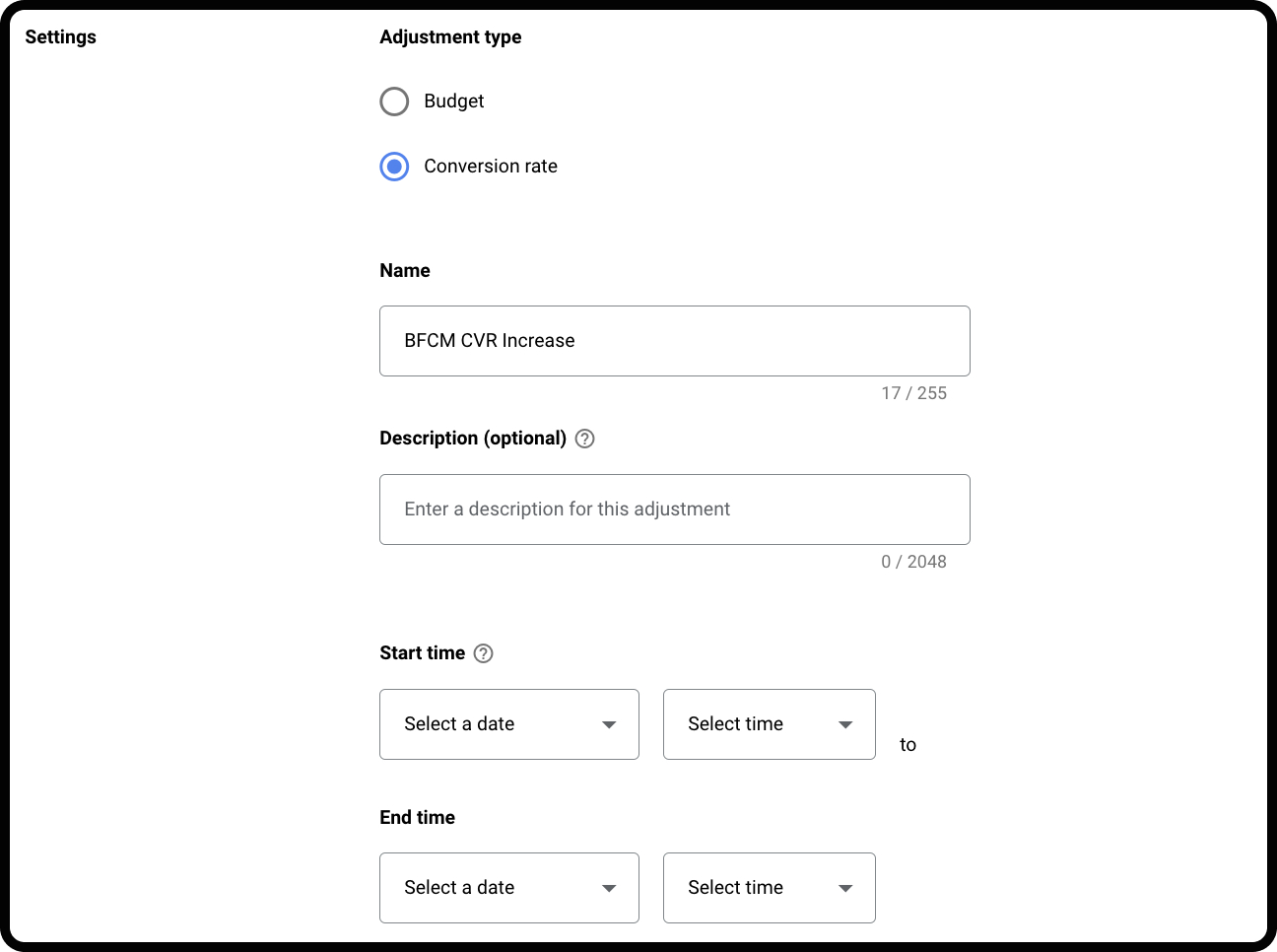As the holiday season approaches, eCommerce businesses gear up for one of the most critical periods of the year, with Black Friday and Cyber Monday (BFCM) leading the charge. In 2023, paid search emerged as the top revenue-driving source during BFCM, highlighting its importance. U.S. consumers spent a remarkable $9.12 billion online on Black Friday alone, up from $8.9 billion in 2022, and projections suggest that this number could soar to $10 billion for the first time in 2024 .
Given this high-stakes shopping period, optimizing Google Ads campaigns becomes crucial to maximize revenue. BFCM presents unique opportunities and challenges for marketers. On one hand, there’s an unprecedented surge in consumer demand; on the other, there’s fierce competition for attention and conversions. To stand out, businesses must fine-tune their SEM strategies, ensuring every dollar spent translates into measurable returns.
In this blog, we’ll delve into practical SEM tips & tricks tailored for BFCM, equipping you with the tools to not just capture attention but to convert it into sales. Whether it’s setting the stage with compelling ad copy, leveraging smart bidding, or optimizing for mobile shoppers, these strategies will help you navigate the dynamic landscape of holiday marketing. Let’s dive in and explore how you can make the most of this lucrative season!
Start Preparing Your Campaigns Early
Don’t wait until the last minute to get your ducks in a row for your Black Friday and Cyber Monday sales. If you’re thinking you can start prepping a week before, you’re already behind the game. The secret sauce to a successful BFCM campaign is all in the groundwork you lay ahead of time. This means having your Google Ads campaigns polished, keywords fine-tuned, & budgets mapped out well in advance. By doing this, you’ll free up valuable time during the actual sale period to focus on evaluating performance and making those crucial but minor, adjustments that could make all the difference. It’s about setting yourself up so that when the clock ticks down to Black Friday, you’re not scrambling but rather strategically navigating the market dynamics.
Set your goals, leverage insights from past performances, and ensure your landing pages and ad copies are optimized and ready to go. By the time BFCM rolls around, you’ll be in a position to maximize revenue rather than play catch-up. This early preparation allows you to pivot quickly and efficiently in response to real-time data, ensuring that your campaigns are running like a well-oiled machine. After all, in the high-stakes world of holiday eCommerce, the early bird really does catch the worm.
Pick BFCM Promo’s That Drive Results
When it comes to boosting sales during Black Friday and Cyber Monday (BFCM), the type of promotion you choose can make all the difference. General percent discounts are proven winners, driving the best results. A whopping 44% of shoppers prefer these discounts, making them the top choice for BFCM promotions. Site-wide percent discounts, in particular, lead to the highest conversion rates, enticing customers with the promise of savings across the board.

Following that the #2 choice is the classic buy one, get one free (BOGO) promotion. This approach is favored by 34% of shoppers and offers a tangible incentive that encourages bulk purchasing, elevating the average order value. The appeal of getting something extra for the money spent makes this promotion a perennial favorite.
On the flip side, early access or exclusive deals don’t seem to hit the mark as effectively. Only 7% of shoppers state this as their preferred deal, suggesting that the allure of exclusivity might not be as strong as the straightforward appeal of immediate savings. Understanding these preferences can help you tailor your promotions to meet customer expectations, ensuring your BFCM strategy is not just competitive but also compelling enough to capture those holiday dollars.
Review Past Performance and Set Goals
Before diving into the holiday frenzy, take a moment to revisit last year’s campaign performance. Look at what worked and what didn’t: examine messaging, keywords, campaigns, ad groups, deals, promos, and products. Lean into strategies that delivered results while pulling back from those that fell short. Did you notice any top efficiency campaigns that lost impression share due to budget constraints? That’s a clue where you might need to allocate more budget this year.
Don’t overlook your search term report from last year, either. Were there search terms driving revenue that you weren’t actively bidding on? Make sure to bid on those this year to increase your chances of showing for those search terms while also catching cheaper CPCs. At the same time, keep an eye out for irrelevant terms that came through, wasting ad spend, and cut them out.

Once you’ve dissected past performance, it’s time to set clear, measurable goals for the upcoming BFCM period. Use your data insights to inform adjustments in strategy, budgeting, and expectations. Knowing where to push and where to scale back can be the difference between a good campaign and a great one. Remember, the data from past performance is your playbook; use it to craft a smarter, more effective strategy for this year’s high-stakes shopping season.
Warn the Algorithm that Change is Coming by Setting Seasonality Adjustments
To prepare for the BFCM rush, it’s crucial to let your algorithm know that a change is on the horizon. This means setting seasonality adjustments to account for the expected surge in budget and conversion rates (CVRs). These adjustments help the algorithm anticipate the increased demand and adjust bidding strategies accordingly. It’s a bit like giving your system a heads-up that things are about to get busy, ensuring it’s not caught off guard.

When setting these adjustments, make sure they’re active for more than seven days. If you are expecting your sale changes to take longer than seven days, consider adding multiple seasonality adjustments.
Take a look at last year’s BFCM conversion rate increase to determine what your adjustment should be. This historical data provides a solid benchmark for expected performance shifts, allowing you to set realistic and effective adjustments. However, be mindful that this approach often results in higher cost-per-clicks (CPCs). It’s a trade-off for staying competitive during peak periods. With the right adjustments in place, your campaigns are better positioned to handle the BFCM frenzy, ultimately leading to more effective bidding and improved overall performance. It’s about setting the stage for success before the holiday shopping bonanza kicks in.
Add New Sales/Deals-Related Keywords to Your Keyword Strategy
As the holiday season approaches, it’s crucial to adapt your keyword strategy to capture the attention of deal-seeking shoppers. We always recommend creating a promo campaign that exclusively targets keywords with sale modifiers. These might include phrases like “Black Friday deals,” “Cyber Monday discounts,” or “holiday sale offers.” By honing in on these terms, you can specifically attract users who are actively searching for promotions ready to shop some deals.

Next, organize your ad groups by products. This segmentation allows you to tailor your messaging and offers more effectively, ensuring that each ad resonates with the specific interests of your audience. It’s essential to max out budgets for these high-intent terms, as they are likely to drive substantial traffic and conversions during the BFCM period.
To determine what keywords to use in your new campaign, review the search term report for inspiration. This report provides insights into the actual terms users are searching for, allowing you to identify additional opportunities for keyword expansion. Look for patterns and trends in the report to uncover new phrases that align with your promotions.
Incorporating these strategies will not only enhance your campaign’s visibility but also position your brand to capitalize on the increased shopping activity during the holiday season. By aligning your keywords with consumer intent, you ensure that your ads are reaching the right audience at the right time.
Optimize your PMax campaigns for sales
To make the most of your Performance Max (PMax) campaigns during BFCM we typically recommend ecommerce accounts follow the following steps:
- Promo Asset Groups: Start by creating a dedicated “Promo” asset group for each sale you’re running. Consistency is key, so ensure the creative and copy you use are aligned across all channels. Running this new asset group with teaser ads a week before the sale not only generates early demand but also helps the algorithm get out of its learning phase, optimizing performance when the main sale kicks off.
- Improving Asset Group Signals: Add promo-related keywords as search themes to capture the attention of deal-seeking shoppers. Also, incorporate audience signals specifically targeting holiday deal seekers, ensuring that your ads reach those most likely to convert.
- Update Your Feed: Don’t forget to update your product feeds to highlight the deals you’re offering. Do this at least 7 days in advance to allow ample time for troubleshooting any feed-related issues that might arise.
- Consolidate your Campaigns: A consolidated approach to product segmentation is recommended, as it aids the algorithm in optimizing more efficiently. Over-segmentation can dilute the effectiveness of your campaign, making it harder for the algorithm to find and focus on winning strategies.
By following these steps, you’ll be well-equipped to leverage PMax campaigns effectively, capturing the attention of your target audience and driving sales during this peak shopping period.
Craft Urgency-Driven Ad Copy and Optimize Landing Pages
Creating urgency-driven ad copy is crucial in capturing the attention of potential customers during the high-stakes BFCM period. Phrases like “limited-time offer” or “only a few left in stock” tap into the psychological triggers of scarcity and exclusivity, compelling users to act swiftly. Countdown timers in ads can further amplify this effect by introducing a tangible deadline, nudging consumers toward immediate action.
But it’s not just about the ad copy; the landing page must echo this urgency. Imagine clicking on an ad promising a flash sale only to land on a generic page with no mention of it. That’s a conversion killer. Ensure your landing pages are not only visually aligned with your ads but also reinforce the same urgent message. They should be designed for seamless navigation, prominently featuring the offer and a clear call-to-action.
Additionally, integrating elements of social proof—like customer reviews or real-time purchase notifications—can enhance credibility and drive engagement. These subtle cues suggest that others are buying and benefiting from the deal, encouraging more users to join in/
In essence, your ad copy and landing pages should work in harmony, creating a cohesive and persuasive user experience that leverages urgency and social proof to drive conversions. This alignment is key to maximizing ROI during BFCM.
Utilize extension assets to promote your sales
Leveraging extension assets in your Google Ads campaigns can significantly enhance visibility and drive more traffic during the BFCM frenzy. We always recommend utilizing all three of these asset extensions for each promo you run:
- Promo extensions are a must-have, allowing you to highlight special promotions like discount codes or limited-time offers. They can accommodate various promo types, whether it’s a monetary or percent discount, giving you flexibility.

Sitelink extensions are another powerful tool. They can direct users to specific sales-related pages or funnel traffic to product pages that historically perform well during sales events. Think custom deals pages, top-performing categories, or those hot-ticket items with irresistible deals.

Headline extensions, which can automatically tailor your ad copy for all ads within a specific campaign or ad group. By adding both a headline and description, you can ensure that your promotions are front and center. Pinning the headline or description guarantees that it shows for every searcher, maximizing your ad’s impact.

Incorporating these extensions isn’t just about adding more content to your ads—it’s about strategically guiding potential customers to the most relevant parts of your site where they’re likely to convert. With the right extensions in place, your ads become more than just attention-grabbers; they turn into conversion-driving machines that help you make the most of the holiday shopping rush.
Leverage Smart Bidding, Audience Targeting, and Remarketing
To make the most of your BFCM campaigns, smart bidding can be your best friend. Automated bidding solutions like Target ROAS or Maximize Conversions Value adjust bids in real-time to optimize for conversions and boost your ROI. This takes the guesswork out of the equation, letting algorithms do the heavy lifting while you focus on strategy.
Precise audience targeting is crucial during BFCM, where every second counts. By zeroing in on high-intent shoppers—those who are most likely to convert—you ensure that your ads reach the right eyeballs at the right time. Use audience insights to craft segments based on behaviors, interests, and past interactions. This way, you’re not just casting a wide net; you’re fishing where the fish are.
Remarketing plays a pivotal role in re-engaging past visitors who may have shown interest but didn’t quite make the purchase. Set up remarketing lists to target these folks with tailored ads, reminding them of the deals they almost snagged. This not only increases your chances of conversion but also maximizes your ad spend by focusing on warm leads. By combining smart bidding, precise targeting, and effective remarketing, you create a trifecta that not only captures but captivates your audience during the high-stakes BFCM period.
Utilize AI Tools for Enhanced Decision-Making
AI tools have revolutionized how marketers approach campaign strategies, especially during high-stakes periods like BFCM. Google’s AI recommendations are a game-changer, offering insights that can help refine your campaign strategies and adapt swiftly to changes in consumer behavior. These recommendations can assist in identifying patterns and trends that might be missed otherwise, enabling you to make data-driven decisions with confidence.
Performance Max campaigns are another powerful AI-driven solution designed to broaden your reach with minimal manual intervention. By leveraging machine learning, these campaigns optimize across all Google channels, ensuring your ads are shown to the most relevant audiences. This means you can effectively capture a diverse range of potential buyers without getting bogged down in the nitty-gritty details of manual optimizations.
By integrating AI tools into your campaign strategy, you’re not just keeping pace with the competition—you’re setting the stage for success.
Optimize for Mobile Shoppers
With mobile shopping becoming increasingly dominant during BFCM, ensuring your campaigns are mobile-optimized is non-negotiable. Mobile devices offer a unique blend of convenience and immediacy, making them the go-to choice for many shoppers seeking quick, seamless experiences. So, how do you make the most of this trend?
First, streamline your mobile ad strategies. Design ad creatives with mobile users in mind by using short, impactful copy and eye-catching visuals that load quickly. The goal is to capture attention while providing an effortless shopping experience.
Next, consider the psychology of mobile shopping. Users often shop on-the-go, meaning your campaigns should cater to this sense of urgency. Incorporate elements that emphasize speed and ease, such as “Buy Now” buttons and simplified checkout processes.
App campaigns are another critical component for those ecommerce brands that have apps. They allow you to engage users directly within your app, which is particularly effective for retaining high-intent shoppers. Ensure your app is not only user-friendly but also optimized for fast loading times and straightforward navigation. By honing in on these strategies, you’ll effectively capture and convert mobile shoppers during the high-stakes BFCM period.
Conclusion
Optimizing your Google Ads campaigns during the high-stakes BFCM period is a game-changer for maximizing revenue. By starting early, reviewing past performance, and setting clear, measurable goals, you lay a solid foundation for success. Implementing seasonality adjustments keeps the algorithm primed for increased activity while adding new sales-related keywords ensures you capture every opportunity.
Crafting urgency-driven ad copy and optimizing landing pages can drive engagement by leveraging psychological triggers. Utilizing extension assets highlights your promotions effectively, and smart bidding, audience targeting, and remarketing enhance your campaign’s reach and impact. Don’t forget to harness AI tools for data-driven decision-making and optimize for mobile shoppers to capture the growing mobile market.
Post-Black Friday, extending deals and nurturing leads maintains momentum and capitalizes on new customer relationships. By incorporating these insights, you’ll enhance visibility, engagement, and sales, making the most of the holiday shopping frenzy. Remember, success in holiday marketing requires continuous learning and adaptation. Stay agile, and you’ll thrive in this dynamic landscape.
Ready to maximize your Black Friday and Cyber Monday sales with a powerful SEM strategy? Contact our team of experts today to get the support you need to drive optimal results.





